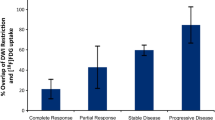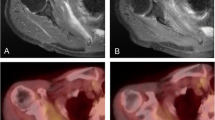Purpose:
To correlate the potential time benefit of 18F-fluorodeoxyglucose positron emission tomography (18FDG-PET) in terms of early detection of recurrences of subcutaneously growing R1H tumors with therapy-specific parameters of recurrent tumor.
Material and Methods:
Twelve, eleven, and seven recurrences were followed after fractionated radiotherapy, surgery, and chemotherapy for 6 months, respectively, and 18FDG-PET was performed weekly using a conventional full-ring whole-body PET scanner. By comparing PET results and actual tumor volume, the time benefit of 18FDG-PET in detection of recurrent tumors of 0.1, 0.2, and 0.5 cm3 was determined for the different treatment strategies.
Results:
A significant time benefit of 18FDG-PET of 26.9 days and 67 days was solely determined for recurrences after radiotherapy of 0.2 cm3 and 0.5 cm3, respectively. The potential time benefit showed a strong correlation with growth delay, which was increased after radiotherapy due to a pronounced tumor-bed effect.
Conclusion:
The potential time benefit of 18FDG-PET is strongly determined by the growth kinetics of the recurrence. A tumor-bed effect, which is a phenomenon solely seen after radiotherapy, favors early detection by 18FDG-PET. The experimental data, clinical experience and theoretical consideration all indicate a noticeable benefit of 18FDG-PET especially after radiotherapeutic treatment.
Ziel:
Bestimmung des Einflusses therapiespezifischer Parameter des Rezidivwachstums auf den potentiellen Zeitvorteil der 18F-Fluordesoxyglucose-Positronenemissionstomographie (18FDG-PET) beim Nachweis von Rezidiven des R1H-Tumors der Ratte.
Material und Methodik:
Rezidive nach fraktionierter Strahlentherapie (n = 12), chirurgischer Entfernung (n = 11) bzw. chemotherapeutischer Behandlung (n = 7) wurden über einen Zeitraum von 6 Monaten wöchentlich einer 18FDG-PET-Untersuchung zugeführt. Durch den Vergleich der 18FDG-PET-Befunde bei einem tatsächlichen Tumorvolumen von 0,1 cm3, 0,2 cm3 bzw. 0,5 cm3 wurde der Zeitvorteil des Rezidivnachweises für die verschiedenen therapeutischen Strategien bestimmt.
Ergebnisse:
Ein signifikanter Zeitvorteil der 18FDG-PET von 26,9 bzw. 67 Tagen konnte nur für Rezidive nach Strahlentherapie nachgewiesen werden. Dieser Zeitvorteil zeigte eine signifikante Korrelation mit der Wachstumsverzögerung der Rezidive, welche aufgrund eines ausgeprägten Tumorbetteffekts nach Strahlentherapie am ausgeprägtesten war.
Schlussfolgerung:
Der potentielle Zeitvorteil der 18FDG-PET wird maßgeblich von der Wachstumskinetik des Rezidivs bestimmt. Der Tumorbetteffekt als ein Phänomen, welches ausschließlich nach Strahlentherapie auftritt und durch verzögertes Rezidivwachstum gekennzeichnet ist, begünstigt die Früherkennung von Rezidiven nach Strahlentherapie mittels 18FDG-PET. Experimentelle und klinische Daten sowie theoretische Überlegungen weisen auf einen ausgeprägten Nutzen von 18FDG-PET, insbesondere bei der Früherkennung von Rezidiven nach Strahlentherapie, hin.
Similar content being viewed by others
Author information
Authors and Affiliations
Corresponding author
Rights and permissions
About this article
Cite this article
Raabe, A., Buchert, R., Seegers, B. et al. Potential Time Benefit in the Assessment of Recurrent Rat Rhabdomyosarcoma Using Positron Emission Tomography (PET) with 18Fluorodeoxyglucose Depends on Therapy-Specific Growth Delay. Strahlenther Onkol 182, 610–615 (2006). https://doi.org/10.1007/s00066-006-1553-5
Received:
Revised:
Issue Date:
DOI: https://doi.org/10.1007/s00066-006-1553-5




